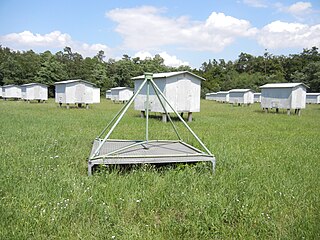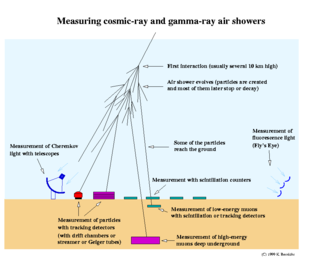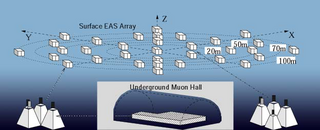
Cosmic rays or astroparticles are high-energy particles or clusters of particles that move through space at nearly the speed of light. They originate from the Sun, from outside of the Solar System in our own galaxy, and from distant galaxies. Upon impact with Earth's atmosphere, cosmic rays produce showers of secondary particles, some of which reach the surface, although the bulk are deflected off into space by the magnetosphere or the heliosphere.

HEGRA, which stands for High-Energy-Gamma-Ray Astronomy, was an atmospheric Cherenkov telescope for Gamma-ray astronomy. With its various types of detectors, HEGRA took data between 1987 and 2002, at which point it was dismantled in order to build its successor, MAGIC, at the same site.

Air showers are extensive cascades of subatomic particles and ionized nuclei, produced in the atmosphere when a primary cosmic ray enters the atmosphere. When a particle of the cosmic radiation, which could be a proton, a nucleus, an electron, a photon, or (rarely) a positron, interacts with the nucleus of a molecule in the atmosphere, it produces a vast number of secondary particles, which make up the shower. In the first interactions of the cascade especially hadrons are produced and decay rapidly in the air, producing other particles and electromagnetic radiation, which are part of the shower components. Depending on the energy of the cosmic ray, the detectable size of the shower can reach several kilometers in diameter.
The Chicago Air Shower Array (CASA) was a significant ultra high high-energy astrophysics experiment operating in the 1990s. It consisted of a very large array of scintillation detectors located at Dugway Proving Grounds in Utah, USA, approximately 80 kilometers southwest of Salt Lake City. The full CASA detector, consisting of 1089 detectors began operating in 1992 in conjunction with a second instrument, the Michigan Muon Array (MIA), under the name CASA-MIA. MIA was made of 2500 square meters of buried muon detectors. At the time of its operation, CASA-MIA was the most sensitive experiment built to date in the study of gamma ray and cosmic ray interactions at energies above 100 TeV (1014 electronvolts). Research topics on data from this experiment covered a wide variety of physics issues, including the search for gamma rays from Galactic sources (especially the Crab Nebula and the X-ray binaries Cygnus X-3 and Hercules X-1) and extragalactic sources (active Galactic nuclei and gamma-ray bursts), the study of diffuse gamma-ray emission (an isotropic component or from the Galactic plane), and measurements of the cosmic ray composition in the region from 100 to 100,000 TeV. For the topic of composition, CASA-MIA worked in conjunction with several other experiments at the same site: the Broad Laterial Non-imaging Cherenkov Array (BLANCA), the Dual Imaging Cherenkov Experiment (DICE) and the Fly's Eye HiRes prototype experiment. CASA-MIA operated continuously between 1992 and 1999. In summer 1999, it was decommissioned.
The High Resolution Fly's Eye or HiRes detector was an ultra-high-energy cosmic ray observatory that operated in the West Desert of Utah from May 1997 until April 2006. HiRes used the "atmospheric fluorescence" technique that was pioneered by the Utah group first in tests at the Volcano Ranch experiment and then with the original Fly's Eye experiment. The version HiRes-II followed later.

The Pierre Auger Observatory is an international cosmic ray observatory in Argentina designed to detect ultra-high-energy cosmic rays: sub-atomic particles traveling nearly at the speed of light and each with energies beyond 1018 eV. In Earth's atmosphere such particles interact with air nuclei and produce various other particles. These effect particles (called an "air shower") can be detected and measured. But since these high energy particles have an estimated arrival rate of just 1 per km2 per century, the Auger Observatory has created a detection area of 3,000 km2 (1,200 sq mi)—the size of Rhode Island, or Luxembourg—in order to record a large number of these events. It is located in the western Mendoza Province, Argentina, near the Andes.
The Haverah Park experiment was a cosmic ray air shower detection array consisting of water Cherenkov detectors distributed over an area of 12 km2 on Haverah Park on the Pennine moorland near Harrogate, North Yorkshire. The experiment was operated by University of Leeds for 20 years, and was switched off in 1987.
The Akeno Giant Air Shower Array (AGASA) was an array of particle detectors designed to study the origin of ultra-high-energy cosmic rays. It was deployed from 1987 to 1991 and decommissioned in 2004. It consisted of 111 scintillation detectors and 27 muon detectors spread over an area of 100 km2. It was operated by the Institute for Cosmic Ray Research, University of Tokyo at the Akeno Observatory.

The LOPES project was a cosmic ray detector array, located in Karlsruhe, Germany, and is operated in coincidence with an existing, well calibrated air shower experiment called KASCADE. In 2013, after approximately 10 years of measurements, LOPES was finally switched off and dismantled.

IACT stands for imaging atmosphericCherenkov telescope or technique. It is a device or method to detect very-high-energy gamma ray photons in the photon energy range of 50 GeV to 50 TeV.

A neutrino detector is a physics apparatus which is designed to study neutrinos. Because neutrinos only weakly interact with other particles of matter, neutrino detectors must be very large to detect a significant number of neutrinos. Neutrino detectors are often built underground, to isolate the detector from cosmic rays and other background radiation. The field of neutrino astronomy is still very much in its infancy – the only confirmed extraterrestrial sources as of 2018 are the Sun and the supernova 1987A in the nearby Large Magellanic Cloud. Another likely source is the blazar TXS 0506+056 about 3.7 billion light years away. Neutrino observatories will "give astronomers fresh eyes with which to study the universe".
Astroparticle physics, also called particle astrophysics, is a branch of particle physics that studies elementary particles of astronomical origin and their relation to astrophysics and cosmology. It is a relatively new field of research emerging at the intersection of particle physics, astronomy, astrophysics, detector physics, relativity, solid state physics, and cosmology. Partly motivated by the discovery of neutrino oscillation, the field has undergone rapid development, both theoretically and experimentally, since the early 2000s.

The GRAPES-3 experiment located at Ooty in India started as a collaboration of the Indian Tata Institute of Fundamental Research and the Japanese Osaka City University, and now also includes the Japanese Nagoya Women's University.

Extragalactic cosmic rays are very-high-energy particles that flow into the Solar System from beyond the Milky Way galaxy. While at low energies, the majority of cosmic rays originate within the Galaxy (such as from supernova remnants), at high energies the cosmic ray spectrum is dominated by these extragalactic cosmic rays. The exact energy at which the transition from galactic to extragalactic cosmic rays occurs is not clear, but it is in the range 1017 to 1018 eV.

A cosmic-ray observatory is a scientific installation built to detect high-energy-particles coming from space called cosmic rays. This typically includes photons, electrons, protons, and some heavier nuclei, as well as antimatter particles. About 90% of cosmic rays are protons, 9% are alpha particles, and the remaining ~1% are other particles.

The GAMMA experiment is a study of:
The Washington Area Large-scale Time-coincidence Array (WALTA) is a cosmic ray physics experiment run by the University of Washington to investigate ultra high energy cosmic rays (>1019eV). The program uses detectors placed at Seattle-area high schools and colleges which are linked via the internet, effectively forming an Extensive Air Shower array. In addition to working on the unexplained levels of Ultra High Energy cosmic ray (UHECR) flux, it hopes to serve as a pedagogical tool for increasing the physics involvement of high schools and community colleges with a University level physics experiment. Each site has three to four scintillation detectors with the goal of having enough sites to cover a 200 km2 area around the city of Seattle. WALTA is a part of the larger NALTA project which hopes to combine data from several WALTA like projects to further the exploration of UHE cosmic rays.
The Tunka experiment now named TAIGA measures air showers, which are initiated by charged cosmic rays or high energy gamma rays. TAIGA is situated in Siberia in the Tunka valley close to lake Baikal. Meanwhile, TAIGA consists of five different detector systems: Tunka-133, Tunka-Rex, and Tunka-Grande for charged cosmic rays; Tunka-HiSCORE and Tunka-IACT for gamma astronomy. From the measurements of each detector it is possible to reconstruct the arrival direction, energy and type of the cosmic rays, where the accuracy is enhanced by the combination of different detector systems.

John David Linsley (12 March 1925 – 15 September 2002) was an American physicist who performed pioneering research on cosmic rays, particularly ultra-high-energy cosmic rays. He did his most significant work from 1959 to 1978 using a ground-based array of detectors at Volcano Ranch in New Mexico. He is best known for being the first to detect an air shower created by a primary particle with an energy of 1020 eV. This was the highest energy cosmic ray observed up to that point. Linsley's observations suggested that not all cosmic rays are confined within the galaxy and showed the first evidence of a flattening of the cosmic ray spectrum at energies above 1018 eV.
The Giant Radio Array for Neutrino Detection (GRAND) is a proposed large-scale detector designed to collect ultra-high energy cosmic particles as cosmic rays, neutrinos and photons with energies exceeding 1017 eV. This project aims at solving the mystery of their origin and the early stages of the universe itself. The proposal, formulated by an international group of researchers, calls for an array of 200,000 receivers to be placed on mountain ranges around the world.














